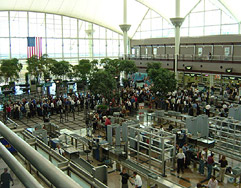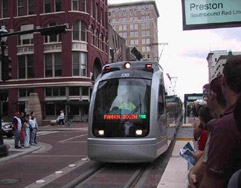Innovation NewsBriefs
Vol. 22, No. 9
Reproduced below are some key quotes from a recently released House T&I Committee document, “Views and Estimates for Fiscal Year 2012.” They offer a first indication of the Committee’s position on the FY 2012 surface transportation budget and the reauthorization bill. The report confirms what congressional sources have been telling us informally for some time— namely, that future federal outlays (spending) on surface transportation will need to be aligned with trust fund revenues from existing user fees. In the Committee’s words, “The Committe is committed to writing a long-term surface transportation authorization bill that keeps the HTF solvent without additional transfers from the General Fund.” Consistent with this policy, the Committee has rejected the Administration’s $556 billion reauthorization proposal and its $50 billion funding request for FY 2012. “The administration’s budget proposal,” the report states, “does not identify a way to pay for these increases without increasing the deficit.”
The document speaks in broad policy terms and does not provide recommended funding levels. However, these can be deduced from the Congressional Budget Office (CBO) estimates. The latest CBO report (March 18, 2011) projects the Trust Fund revenues at $232 billion over the next six years, FY 2012-2017 ($201billion for the Highway Account and $31 billion for the Transit Account). Another $22 billion is estimated to remain unspent in both Trust Fund accounts at the end of Fiscal Year 2011. Thus, the total sum available to fund the next six-year authorization (FY 2012-2017) would amount to $254 billion (or an average of $42 billion/year) —assuming, that is, that Congress would maintain its commitment to limit annual budget authority to revenues raised through the gas tax, and forswear any additional transfers from the General Fund. By comparison, the five-year SAFETEA-LU authorization was funded at $244.1 billion or an average of $49 billion/year.
The “Views and Estimates” report was approved by the full Committee (with dissenting opinions) and transmitted to the House Budget Committee on March 18. Under the Congressional Budget Act and House rules, each legislative committee is required to submit its views and estimates on the forthcoming budget to the Budget Committee to assist in the preparation of a budget resolution. The House Budget Resolution is expected to be made public by mid-April.
…
“The Federal government is on an unsustainable fiscal path that poses a critical threat to our economy. To address this threat, the Federal budget deficit must be reduced. As part of this effort, the Committee is recommending funding reductions for many programs within its jurisdiction. …As we seek to do more with less, the Committee will also work to ensure that infrastructure investments funded by these programs are those that make sense and will yield the greatest benefit for the least cost. …” (p.1)
“One of the Committee’s highest priorities is to ensure that the user fees deposited into these trust funds are in fact used for their intended purposes— to rebuild our nation’s infrastructure. …” (p.2)
“The Committee does not support the proposal in the FY 2012 President’s Budget to shift all funding for surface transportation programs to the mandatory side of the budget because this proposal fails to recognize the need to link Trust Fund revenues to spending to adequately establish the user fee-based premise of the Trust Fund. …” (p. 3)
“The [President’s] request proposes to rename the Highway Trust Fund the “Transportation Trust Fund.” This new trust fund would include the current Highway Account and Mass Transit Account as well as two new accounts for Passenger Rail and the proposed National Infrastructure Bank. The administration’s proposal is silent on how the Transportation Trust Fund will have sufficient revenue to fund these new programs. …” (p. 17)
“The Committee cannot support the administration’s proposed reauthorization funding level [of $556 billion] because it fails to specifically identify how to pay for the $435 billion revenue gap [over a 10-year period]. …” (p. 17)
“The Committee is supportive of eliminating surface transportation programs that are no longer in the Federal interest and consolidating programs that overlap or are duplicative. …” (p. 17)
“The Committe is committed to writing a long-term surface transportation authorization bill that keeps the HTF solvent without additional transfers from the General Fund. Given that the existing revenues from the existing user fees are not adequate to support the investment needs, the Committee will consider ways to meet the challenges and needs by doing more with less. This includes but is not limited to programs and policies that promote innovative financing and public private partnerships. …” (p. 17-18)
“The Committee is also committed to accelerating the project delivery process for surface transportation projects. … The next surface transportation authorization bill will make major improvements to the project delivery process…allowing states and public tranit agencies to do more with less.” (p.18)
“The Committee is interested in exploring ways to better leverage the existing HTF revenues. The Committee will consider expanding and improving existing DOT loan programs such as the Transportation Infrastructure Finance and Innovation Act (TIFIA) program and the Railroad Infrastructure Finance (RRIF) program. …” (p. 18)
“Current HTF revenue cannot support this level of investment [$70.4 billion for highways in FY 2012] and the Budget proposal is silent on how to generate the additional revenues to fully support these programs. The Committee cannot support the proposed funding increases because the administration’s budget proposal does not identify a way to pay for these increases without increasing the deficit. …” (p. 18) [identical wording for the transit program]
“Currently, there are over 55 separate highway programs. The Committee believes that many of these programs should be consolidated and replaced with a relatively small number of core highway programs. …” (p. 18)
“The Committee is supportive of restructuring the Federal surface transportation pograms and eliminating programs that are no longer in the Federal interest and of consolidating programs that overlap or are duplicative…” (p.19)
“The Committee supports reducing appropriations for Amtrak and pressing for full enactment of private sector participation initiatives included in the Passenger Rail Improvement Act of 2010. … In late 2010, Amtrak proposed a “Vision Plan” to bring the NEC [Northeast Corridor] up to world-class high-speed rail standards by building dedicated high-speed tracks on new right-of-way between Washington, D.C. and Boston. Unfortunately, this vision would cost $117 billion and take 30 years to implement. Amtrak’s historical failure to successfully execute capital projects strongly suggests that the United States should explore alternative solutions for future high-speed rail service on the NEC. …” (p.21)
http://republicans.transportation.house.gov/Media/file/112th/Views_and_Estimates_FY2012.pdf
…
C. Kenneth Orski is a public policy consultant and former principal of the Urban Mobility Corporation. He has worked professionally in the field of transportation for over 30 years, in both the public and private sector. He is editor and publisher of Innovation NewsBriefs, now in its 22nd year of publication.
Tags: C. Kenneth Orski, Innovation Newsbriefs, Ken Orski, Reauthorization






 RSS Feed
RSS Feed